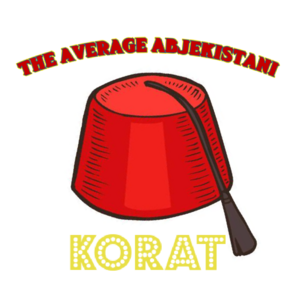Abjekistan: Difference between revisions
No edit summary |
No edit summary |
||
| Line 19: | Line 19: | ||
| 9% [[Mehrava|Mehranis]] | | 9% [[Mehrava|Mehranis]] | ||
| 5% [[Encessia|Encessians]] | | 5% [[Encessia|Encessians]] | ||
| 3% [[ | | 3% [[gassasinia|Gassasinians]] | ||
| 2% [[siruth|Siruthians]] | | 2% [[siruth|Siruthians]] | ||
| 5% Others | | 5% Others | ||
Revision as of 20:28, 2 February 2021
People's Republic of Abjekistan Өзбекстан Халық Республикасы | |
|---|---|
| Motto: Бірлік, бейбітшілік, өркендеу Birlik, beybitşilik, örkendew ("Unity, Peace, Prosperity") | |
| Anthem: Абджек халқы бірге Abdjek xalqı birge ("Together, Abjekh people") | |
| Capital | Noruzabad |
| Official languages | |
| Ethnic groups |
|
| Religion |
|
| Demonym(s) | Abjekistanian |
| Government | Socialist Democracy (WIP) |
• Regional Representatives | 6 Delegates |
• District Representatives | 36 Delegates |
• Municipality Representatives | approx. 150 Delegates |
• Electors | The Population |
| Population | |
• January 2020 estimate | 10,722,000 |
| GDP (PPP) | 2020 estimate |
• Total | ~$357 billion |
| Currency | Puzhaks (ABP) |
| Driving side | right |
| Calling code | +151 |
| Internet TLD | .Ab |
The People's Republic of Abjekistan is a large, cultured nation, remarkable for its barren, inhospitable landscape, irreverence towards religion, and devotion to social welfare. The quiet, industrious population of 85 million Abjekistanians are fiercely patriotic and enjoy great social equality; they tend to view other, more capitalist countries as somewhat immoral and corrupt.
The enormous government juggles the competing demands of Administration, Education, and Welfare. The average income tax rate is 69.1%, and even higher for the wealthy.
The Abjekistanian economy, worth 3.97 trillion Puzhaks a year, is quite specialized and led by the Information Technology industry, with significant contributions from Book Publishing, Uranium Mining, and Tourism. State-owned companies are reasonably common. Average income is 46,742 Puzhaks, and distributed extremely evenly, with little difference between the richest and poorest citizens.
Politics (WIP)
Government (WIP)
There are no political parties in Abjekistan. Abjekistanians vote for their District Representants (There are 6 districts by region), who then elect a Regional Representant. The RRs then elect ministry members, supreme court members, etc. The power is thus divided between the people, the District Representants and the Regional Representants.
List of Ministries
- Ministry of Foreign Relations (AMFR)
- Ministry of Culture and Medias (AMCM)
- Ministry of the Automotive Industry (AMAI)
- Ministry of the Finance and Economy (AMFE)
- Ministry of Healthcare and Welfare (AMHW)
- Ministry of Defense (A-MD)
- Ministry of Education (A-ME)
- Ministry of the Transports (A-MT)
- Ministry of Justice (A-MT)
- Ministry of the National Militia (AMNM)
- Abjekistan Investigation Bureau (AIB)
Culture
Music[1]
Abjekhs love active and entertaining music, such as Bouzoukis, Kasatchoks and and traditional Yadakk music. The most popular dances are group dances, like the Koshandan line dance [2], which originates from the massive Thuadian immigration wave in the 1880s, and the Abjekh kick dance.
Fashion
The traditional Abjekh clothing may vary according to the regions, but the Abjekh outfit constitutes of a burgundy fez, a White Tchekeska, colored baggy pants and high boots for men. Women often wear the Perankh, a colorful dress decorated with golden flowers.
Medias
The region of Koshanda, the former Abjekistan capital, is recognized for its soap operas, musicals and humoristic programs. The most popular is certainly Korat, the average Abjekistani. Korat is a weekly humoristic television show recounting the hectic life of Korat Belmuth, a citizen of the small city of Sirmak, located in the eastern Cheburek plains.


